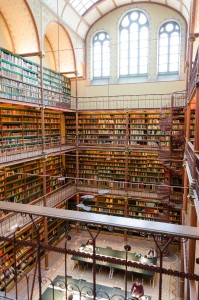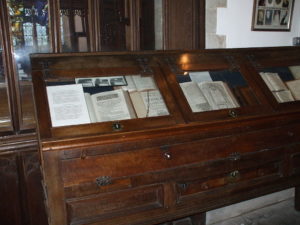Books are precious things and, as regular readers will know,  The Story Bazaar loves a library, real or fictional.
The Story Bazaar loves a library, real or fictional.
In The Name of the Rose, a forgotten volume of Aristotle’s Poetics was hidden in a labyrinthine library and its secrets protected by a serial murderer. In The Library of Babel Jorge Luis Borges plays with the idea of a library containing every book ever written, or to be written, but of no practical use because the words and characters are dispersed among the volumes.
Real libraries are often beautiful and sometimes strange ( though not as strange as in Borges ). Some of the older ones are ‘chained’, their books linked by chains to the shelves, so that the user can only consult them in situ, not take them away. By a coincidence I have visited a number of these.
 The smallest, and most local to me, is in Chelsea Old Church, a gift from Sir Hans Soane. It is a small cabinet of a library containing a number of theological texts. The church itself is a post war construction, much of it having been destroyed in WWII, except for Sir Thomas More’s chapel, built by him for worship in the sixteenth century ( he lived close by ). It is still worth a visit.
The smallest, and most local to me, is in Chelsea Old Church, a gift from Sir Hans Soane. It is a small cabinet of a library containing a number of theological texts. The church itself is a post war construction, much of it having been destroyed in WWII, except for Sir Thomas More’s chapel, built by him for worship in the sixteenth century ( he lived close by ). It is still worth a visit.
There are similar chained libraries in a number of churches. In Somerset at All Saints, Wrington ( which has an interesting link with Clapham in that it contains a bust of Hannah More an active member of that branch of the anti- slavery movement centred on Clapham ), St Wulfram’s Church, Grantham, aka the Francis Trigge Library and St Peter’s Church, Wooton Wawen, Warkwickshire ( see photograph right ).
slavery movement centred on Clapham ), St Wulfram’s Church, Grantham, aka the Francis Trigge Library and St Peter’s Church, Wooton Wawen, Warkwickshire ( see photograph right ).
The largest chained library in the UK is probably the oldest, that at Hereford Cathedral, which was founded over 900 years ago, though the chaining of books started in the late sixteenth century. The Mappa Mundi, the largest medieval map of the world known to exist, was housed in the library until acquiring its own building. Wimbourne Minster in Dorset is second largest, containing chained books since 1686, closely followed by Wells Cathedral chained library housed in part of the Cathedral from the fifteenth century.
 Some years ago while on a visit to Dublin I visited Marsh’s Library, which was founded by Archbishop Marsh and first opened to the public in 1707. You can still visit today ( see web-site ). Marsh’s also still has its ‘reader’s cages’ in place, actual wired alcoves where readers would be locked in if they wanted to consult especially rare books. They are, however, no longer in use.
Some years ago while on a visit to Dublin I visited Marsh’s Library, which was founded by Archbishop Marsh and first opened to the public in 1707. You can still visit today ( see web-site ). Marsh’s also still has its ‘reader’s cages’ in place, actual wired alcoves where readers would be locked in if they wanted to consult especially rare books. They are, however, no longer in use.
Closer to home, some schools have chained libraries. When I  worked for a time in Guildford I visited the Royal Grammar School there, a foundation of 1509, but now an independent fee-paying institution. The library dates from 1575, containing volumes from before that date and was almost burned down during a fire at the school in 1962. Fortunately it was saved.
worked for a time in Guildford I visited the Royal Grammar School there, a foundation of 1509, but now an independent fee-paying institution. The library dates from 1575, containing volumes from before that date and was almost burned down during a fire at the school in 1962. Fortunately it was saved.
 The one thing shared in common by all the chained libraries is their age, so I leave you with a modern version, but not so much chained as boxed and with the opposite purpose. To encourage people to take and read books. The Little Free Library was begun in the US but is now found throughout the world. I passed a British version in Walthamstow only the other day ( see Twitter ).
The one thing shared in common by all the chained libraries is their age, so I leave you with a modern version, but not so much chained as boxed and with the opposite purpose. To encourage people to take and read books. The Little Free Library was begun in the US but is now found throughout the world. I passed a British version in Walthamstow only the other day ( see Twitter ).
If you enjoyed reading this article and would like to read more about libraries and books why not try The First Library When is a Tea Towel not a Tea Towel?


 RSS – Posts
RSS – Posts